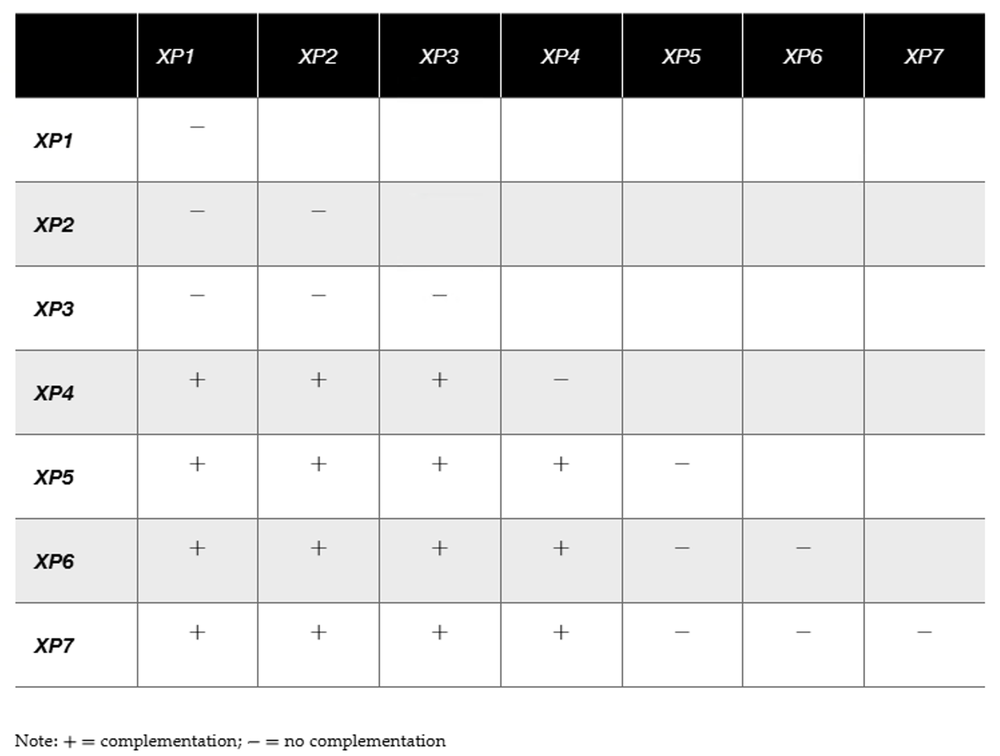Table of contents
- 1. Introduction to Genetics51m
- 2. Mendel's Laws of Inheritance3h 37m
- 3. Extensions to Mendelian Inheritance2h 41m
- 4. Genetic Mapping and Linkage2h 28m
- 5. Genetics of Bacteria and Viruses1h 21m
- 6. Chromosomal Variation1h 48m
- 7. DNA and Chromosome Structure56m
- 8. DNA Replication1h 10m
- 9. Mitosis and Meiosis1h 34m
- 10. Transcription1h 0m
- 11. Translation58m
- 12. Gene Regulation in Prokaryotes1h 19m
- 13. Gene Regulation in Eukaryotes44m
- 14. Genetic Control of Development44m
- 15. Genomes and Genomics1h 50m
- 16. Transposable Elements47m
- 17. Mutation, Repair, and Recombination1h 6m
- 18. Molecular Genetic Tools19m
- 19. Cancer Genetics29m
- 20. Quantitative Genetics1h 26m
- 21. Population Genetics50m
- 22. Evolutionary Genetics29m
17. Mutation, Repair, and Recombination
Spontaneous Mutations
Problem 24
Textbook Question
Presented here are hypothetical findings from studies of heterokaryons formed from seven human xeroderma pigmentosum cell strains:

These data are measurements of the occurrence or nonoccurrence of unscheduled DNA synthesis in the fused heterokaryon. None of the strains alone shows any unscheduled DNA synthesis. Which strains fall into the same complementation groups? How many different groups are revealed based on these data? What can we conclude about the genetic basis of XP from these data?
 Verified step by step guidance
Verified step by step guidance1
Analyze the complementation table provided. Complementation occurs when two strains (+) can compensate for each other's defect, indicating that the mutations are in different genes. No complementation (-) means the mutations are in the same gene.
Identify the rows and columns where complementation does not occur (-). For example, XP1 does not complement XP2, XP3, and so on. This suggests that these strains share mutations in the same gene.
Group the strains based on the lack of complementation (-). Strains that do not complement each other belong to the same complementation group. For example, XP1, XP2, and XP3 may form one group if they all fail to complement each other.
Count the number of distinct complementation groups. Each group represents a unique gene involved in the process being studied (in this case, DNA repair in xeroderma pigmentosum).
Conclude that xeroderma pigmentosum is genetically heterogeneous, meaning it is caused by mutations in multiple genes. Each complementation group corresponds to a different gene involved in the DNA repair pathway.
 Verified video answer for a similar problem:
Verified video answer for a similar problem:This video solution was recommended by our tutors as helpful for the problem above
Video duration:
1mPlay a video:
Was this helpful?
Key Concepts
Here are the essential concepts you must grasp in order to answer the question correctly.
Complementation Testing
Complementation testing is a genetic technique used to determine whether two mutations that produce a similar phenotype are in the same gene or in different genes. In this context, if two strains can complement each other (indicated by a '+'), they are likely in different complementation groups, meaning they have mutations in different genes. Conversely, if they cannot complement each other (indicated by a '-'), they are in the same complementation group, suggesting that both strains have mutations in the same gene.
Recommended video:
Guided course

Complementation
Heterokaryons
Heterokaryons are cells that contain two or more genetically distinct nuclei within a common cytoplasm, often formed by the fusion of different cell types. In the study of xeroderma pigmentosum (XP), heterokaryons allow researchers to assess whether the genetic defects in DNA repair mechanisms can be compensated by the presence of functional alleles from another strain. This is crucial for understanding the genetic basis of XP and identifying which strains share similar genetic defects.
Xeroderma Pigmentosum (XP)
Xeroderma pigmentosum (XP) is a rare genetic disorder characterized by extreme sensitivity to ultraviolet (UV) light, leading to a high risk of skin cancer. It is caused by mutations in genes responsible for nucleotide excision repair, a mechanism that repairs DNA damage caused by UV exposure. Understanding the complementation groups among XP strains helps elucidate the specific genetic defects involved in the disorder and can inform potential therapeutic approaches.
Related Videos
Related Practice
Textbook Question
What is a spontaneous mutation, and why are spontaneous mutations rare?
1048
views


